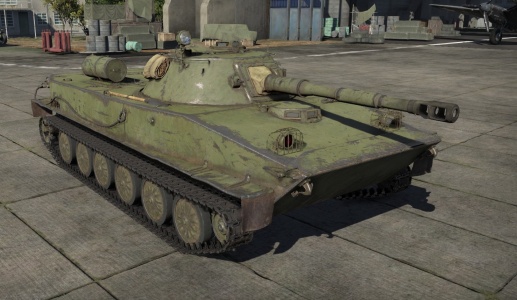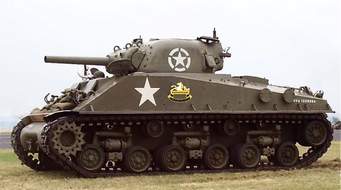

A T-34/76 Model Russian medium tank from World War II. This version has a shorter, lower velocity main gun. The T-34/85 had a longer barrel high velocity gun. The slope of the frontal armor made the T-34 harder to "kill" than the M4 Sherman medium tank used by United States and British forces in World War II. The T-34 was in the reserves of the Red (Russian) Army at least into the mid-70s or early 80s, and appeared in the 2015 WWII Victory Anniversary parades in Russia. This tank had a Christie chassis, named for US inventor Walter Christie, and was constructed at the Ford Motor Company-built facility at Gorki, and another US-provided facility at Chelyabinsk.
As if manufacturing the propellant powder for the bullets and shells fired out of Soviet (Russian) rifles, pistols, machine guns, artillery pieces, and mortars was not enough, the United States, and its European allies, constructed entire manufacturing facilities inside Russia for the production of tanks, self-propelled guns, armored personnel carriers, and other armored vehicles. A Soviet (Russian) defector during the Cold War described a Russian attack as being "a storm of artillery followed by an avalanche of tanks." We will see that, without the material aid of U.S. corporations, and the approval of the United States State Department and Commerce Department, the Red (Russian) army and its North Korean and North Vietnamese allies, would not have had tanks to use against our own men in Korea and Vietnam. Now, I realize that it is a very pressing matter for most of you to get in line to get the next version of the I-Phone, but you might want to find out about your own corporations and government providing the technology for BOTH SIDES of two different "hot" wars as well as a Cold War. At least I thought the American people just might be interested in something like that, despite knowing about this since 1972 and being ignored by scores of people who could really care less, or just don't want to believe it. It's too bad that attitude can get so many people killed. How many more it will kill we will just have to wait and see, won't we? The end game here might be more horrible than any of you can possibly imagine.
Tractor, locomotive, and automobile plants can be converted to the production of tanks and other armored military vehicles. Most of Russian tractor and locomotive production facilities were supplied by United States corporations with the permission of the United States State Department and Commerce Department. This is readily proven by this list of United States manufacturers of tractors that provided such entire production facilities ot the Soviet Union (Russia) from the late 1920s through the 1970s.
|
|
|
|
|
|
|
|
|
|
|
|
Western European contributions to the manufacturing of Soviet (Russian) tanks and armored vehicles include:
|
|
|
|
|
|
|
|
|
|
|
|
The best production facilities for tanks in Russia were their tractor plants. Massey-Harris in the United States is a good example of a tractor plant that converted to the production of tanks during World War II. The Russians did the same thing as we did, converting their tractor plants over to tank production, but the Soviets (Russians) did it far earlier, producing mostly tanks in many of their "tractor" plants, which probably made their famines of the 1930s worse. The Russians always built their tractors using treads, or tracks, just like a tank, rather than wheels and tires, which made the changes from tractors to tanks easier. In addition, as occupying German forces reported during World War II, the Russians made changes in their manufacturing that enabled faster conversions from tractor production to tank production. This is called "Planned Adaptability," and involves specialized manufacturing attachments and equipment and machinery held in reserve. American observers noted this in the 1930s, as described in Horace Filbert's book, The Russian Industrialization Program.

The American-built Stalingrad "Tractor" plant is enormous. This facility was pre-fabricated and built entirely in the United States prior to being disassembled and shipped to Stalingrad where it was reconstructed on concrete pads inside of steel buildings. The buildings were also manufactured inside the United States. This plant is a Caterpillar Tractor plant built by 570 Americans and 50 Germans. John Calder, of the Austin Company supervised the construction project. Following is a list of the US firms that supplied machinery and equipment that went into the construction of the "tractor" plant.
|
|
|
|
|
|
|
|
|
|
|
|
|
|
|
|
|
|
|
|
|
|
|
|
|
|
|
During the Vietnam War, the PT-76 Russian amphibious tank was produced at the Stalingrad plant. The PT-76 was used against American and South Vietnamese troops during the war, and played a significant role in the final North Vietnamese offensive in South Vietnam.
The Russians attempted to build this copy of the Stalingrad Caterpillar plant on their own. They started the project in 1930, but by March 1931, the project was hopelessly bogged down. The Russians turned to the United States to restart the project. John Calder, the American engineer who supervised construction of the Stalingrad "tractor" plant, took over the project. Later on, John Thane, a former Caterpillar employee, replaced John Calder. The result was that the Chelyabinsk "tractor" plant was producing copies of Caterpillar tractors by the end of 1931, when the facility was supervised by American engineers who were all former Caterpillar employees.
In addition to the copies of Caterpillar crawler tractors--using treads instead of wheels and tires--the Chelyabinsk plant was turning out tanks of the Russian BT series. The BT series is important as it was one of the first in the world mass produced on the Christie torsion bar suspension chassis. The Christie suspension was invented by American Walter Christie, and the rights to the design were owned by US Wheel Track Layer Corporation. Walter Christie was financed in his efforts to design the torsion bar suspension by U.S. Army general George S. Patton. Christie's torsion bar suspension revolutionized tank design. The Russians recognized the prototypes they were permitted to inspect in the 1930s as being a breakthrough and purchased rights to reproduce it. The purchase had to be approved by the US government. This was a direct transfer of military technology to the Russians. No one can claim that the intent was to help Russia build tractors or some other benign, civilian-use vehicle. Christie made a tank, not a tractor. You can see a similarity in the look of the US M4 Sherman and the Russian T34 as shown below. Both were built on the Christie chassis. American soldiers described the body of the Sherman as looking like an upside down soap dish. The T34 shares that same body shape, but the armor had a different degree of slope that made it harder to destroy than the Sherman.

An early M4 Sherman Medium Tank. Note the similarity in the frontal armor shape with the T-34. The early Shermans had 75 millimeter guns that lacked the velocity and mass needed to penetrate the frontal armor of German tanks. |

|
The first Christie design tanks also used the same engine design. Both the M4 Sherman and the T-34 used a Liberty 12-cylinder V-type 338 Horsepower engine with forced water cooling. Later, the Russians used a copy of a German engine, a V-type diesel designed by BMW.
Leon A. Swajian, an American engineer, was the chief construction engineer on the Ford Motor Company's River Rouge "Tractor" plant near Kharkov, Russia. According to Swajian, the plant took 12 years to complete, and was comprised of all US and German equipment. The forge shop was comprised entirely of American machinery and technology. The furnance and temperature controls were provided by Leeds and Northrup of Philadelphia.
By late 1932, the Khardov plant was turning out eight to ten tanks daily. Kharkov was dedicated more to tank production than to tractor production. The first tank model produced was the T-26, a Christie chassis tank, along with armored cars and self-propelled guns.
Ford's Gorki facility truned out the Russian T-32 and T-34/85 medium tanks used in World War II and in the Korean War by North Korean forces.
Russian tank production and design was wholly dependent on the aid of sources originating in the United States. US corporations provided the machinery, equipment, plant design, and construction supervision, along with training to the Russians. Tank production by the Russians would have been a problem without American help. This American help continuted through the Cold War, and I suspect continues to this day. American corporations, with the aid and permission of the United States government, brought the Russian military-industrial complex into the age of the computer in the 1970s. There is no reason to think this would ever stop, even with today's media hysteria about Russia, which was completely non-existent in the 1930s, 1940s, 1950s, 1960s, 1970s, 1980s, and the 1990s. Media hostility toward Russia is a very recent phenomenon. It correlates to the very bizarre election campaign we are studying now, which is too late, of course, to stop our own government and corporations from building the enemy the media now decries solely because their favored candidate lost. Media concern about Russia is, as usual for them, too late, which means too late to save any of the American lives lost to this phenomenon of building up an enemy in Russia.
We did the same favors to China, but on a much larger scale. China's revolutionary military/industrial development progressed even faster producing, in only 15 years, the military power we see today, all on US technology.
NEXT: US CORPORATIONS AND GOVERNMENT PROVIDE THE SOVIET UNION (RUSSIA) WITH THE LARGEST TRUCK PLANT ON EARTH DURING THE VIETNAM WAR.
Primary Source: Sutton, Antony: National Suicide: Military Aid to the Soviet Union, Arlington House, 1972